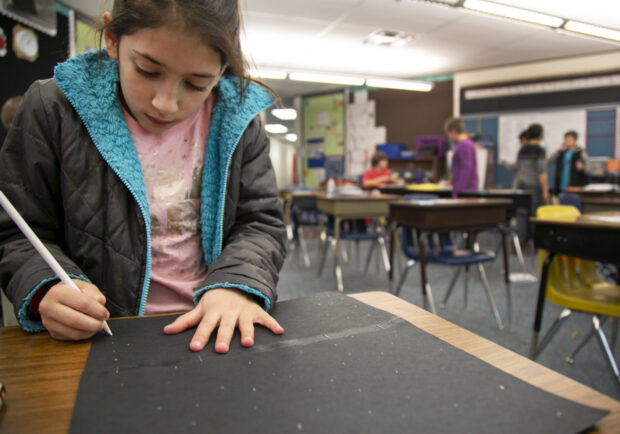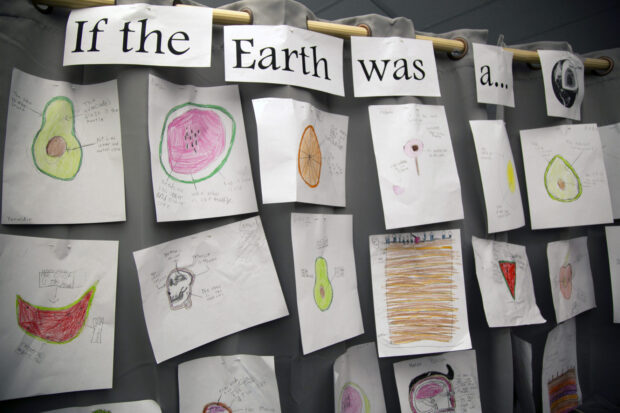When Aimee Christensen asked her Centennial Elementary School students to partner-up for a line-reading exercise, fourth-grader Genesis Phelps made a beeline for the board.
She wasn’t looking for chalk or a marker. Instead, she grabbed a pointer and flipped it upside down. Suddenly, Phelps and the pointer transformed. Phelps was no longer a small girl in a pink unicorn sweater, but an old man, teaching his grandson about Cesar Chavez; the blackboard pointer, his cane.
“Rather than sitting down and asking questions about Cesar Chavez, I found a play,” Christensen explained over the chatter of fourth-graders in character.
The lesson is one example of a push toward arts-integrated learning at Centennial Elementary, which serves some 500 elementary and kindergarten students in Nampa. For the past two years Principal Paul Harman has led the charge for integrating arts into the classroom, with the hopes that it will engage students and help them retain information.
“When you do the arts children are more engaged, which translates to other skillsets,” Harman said. “…When you’re engaged, you’re training your brain to be engaged.”
Centennial teachers say they’ve seen a change. Some say their students are retaining more information. Others say they’re capturing the attention of more students than they might have before.
“More of them are learning more,” fifth-grade teacher Camille Trent said of her students. “You’re hitting a wider range of kids… Those kids that normally might not be engaged are also engaged.”

District and school administrators hope that the new focus will lead to a measurable improvement in achievement outcomes at Centennial.
Centennial’s students did see a bump in their ISAT test scores in the 2017-2018 school year, which Harman thinks could be in part because of the arts. However, other factors like a school focus on writing could have also contributed to the change, he said.
In the 2017-2018 school year, 50.4 percent of Centennial elementary students scored proficient in English Language ISAT tests, compared to 33.1 percent the year before. Math scores were similarly improved, up to 34 percent proficiency from 28 percent.
“I’m hoping [arts integration] was part of it, but I think it will tell over time as we do more and more,” Harman said. “To fully see the effect on students, I think it’ll take time.”
Harman is quick to point out that Centennial Elementary is using the same curriculum as the rest of Nampa’s elementary schools. And incorporating arts into the classroom isn’t a new concept, he said, but he’s asking teachers to do it more intentionally.
“It’s asking a lot more of teachers to be creative themselves in order to ask students to be creative,” Harman said. “…That’s probably the biggest hurdle is just helping teachers change their way of thinking.”
The integration is happening gradually, Harman said, as teachers adapt at their own pace.
“We’re there to support them along the way,” he said. So far, Harman said, his teachers are on board.
Teacher Bernie Goeden, who has been at Centennial Elementary for seven years, said he loves the new focus. He had already been incorporating art into his teaching, he said, but he does it more frequently now and he thinks it’s making a difference.
“It gets them more motivated,” Goeden said of the students. “They remember a lot more.”
For example, Goeden said, sometimes his students will act out how to sound out vowels or reading words with little skits. Afterward, when they work on those words, he’ll see them making motions from those skits as they remember the lesson.

Evidence of the school’s new motto: “Foundational skills colored with creativity,” decorate the walls at Centennial.
In a third grade classroom drawings of fruits, candies and skulls decorate one wall, left over from a science lesson. The eclectic collection marks the third-graders responses to the prompt: “If the Earth was a…”
If the Earth was a TootsiePop, some students decided, the tootsie roll would be it’s molten core.
Other students drew the earth as an avocado, with a pit-core at its center. And a few students made a much different argument. If the Earth was like a head, they figured, the skin would be like the crust, and the brain the Earth’s core.
In the hallway near the front door, Harman built a small stage, which the students use to perform. One of his hopes is that the arts-focus can help them build courage and get a jump-start on life-skills like public speaking.
“We are not educating these children for fourth grade or fifth grade, we’re educating these children for life,” Harman said.
For the students, the art is just plain fun.
“Acting, I like it. It’s more fun than just learning about a story and moving on,” said Gavin Woolstenhulme, who was trying out accents while he traded lines with his acting partner in Christensen’s fourth-grade class. “.. Most schools, they just learn about the story and don’t have any fun with the story. If I were them, I would think that’s boring.”
